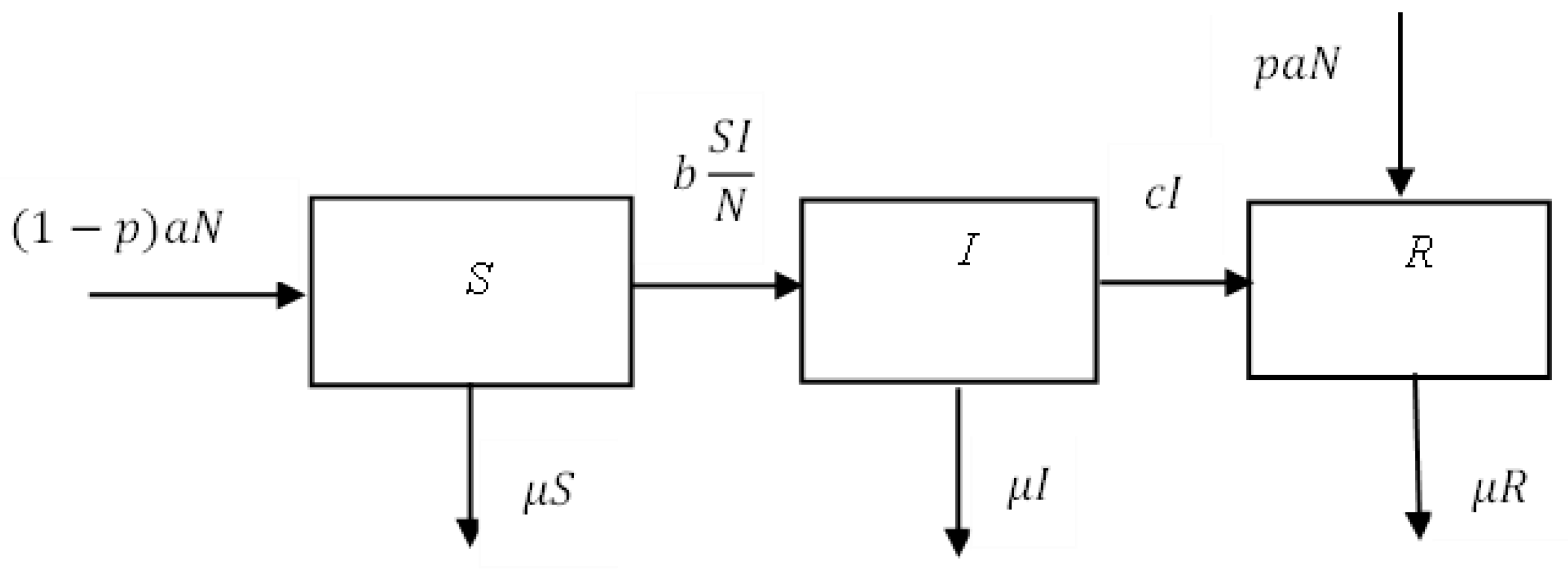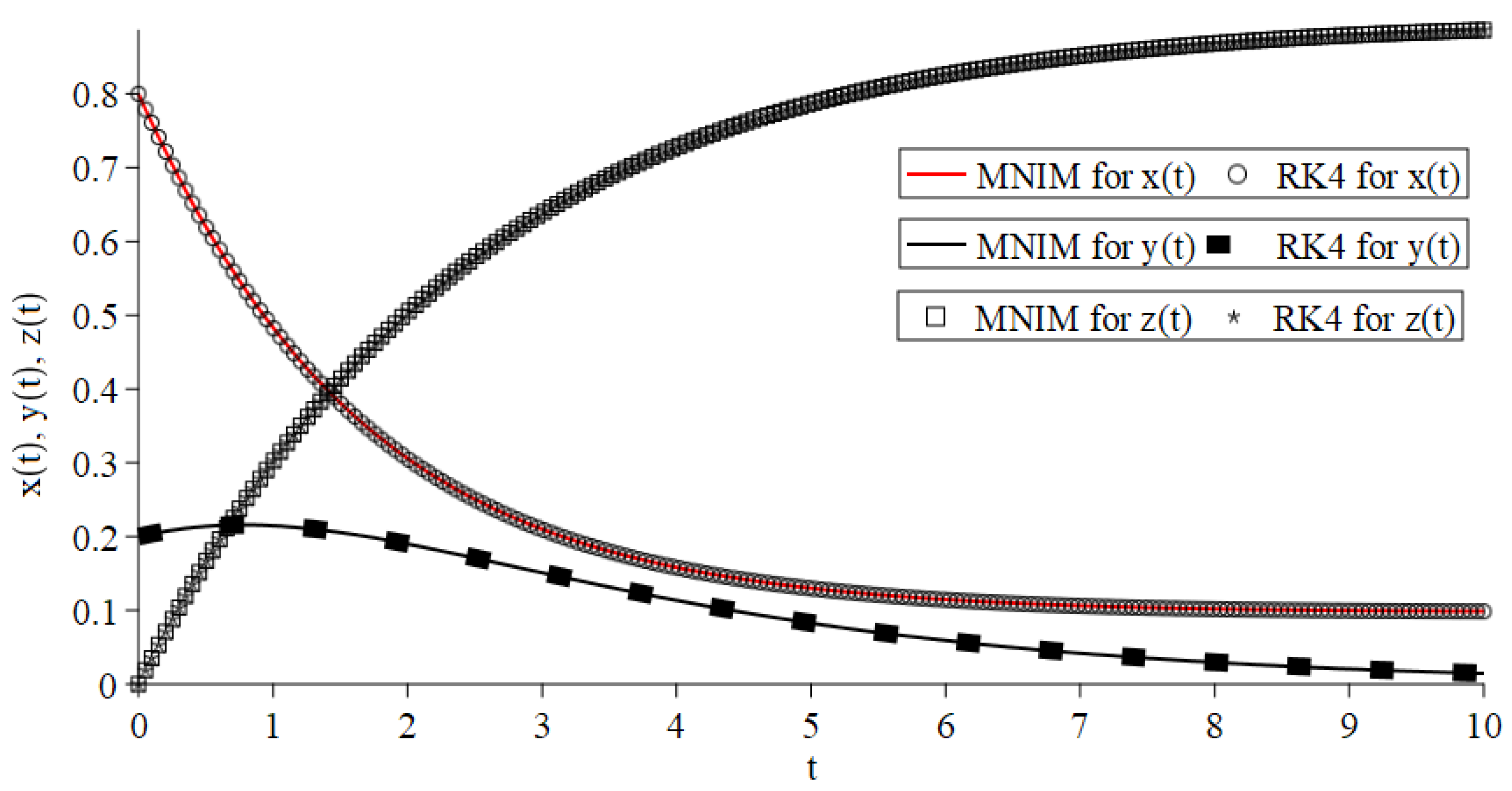Accurate Numerical Treatment on a Stochastic SIR Epidemic Model with Optimal Control Strategy
Abstract
:1. Introduction
2. Solution Procedure
2.1. New Iterative Method
2.2. Modified New Iterative Method
2.3. Convergence Analysis of MNIM
3. Application
3.1. Solutions by NIM
3.2. Solutions by MNIM
4. Results and Discussions
4.1. NIM Solutions
4.2. MNIM Solutions
4.3. Comparison of the Solutions for SIR Epidemic Model
5. Conclusions
Author Contributions
Funding
Institutional Review Board Statement
Informed Consent Statement
Data Availability Statement
Conflicts of Interest
References
- Li, M.Y. Important Concepts in Mathematical Modeling of Infectious Diseases. In An Introduction to Mathematical Modeling of Infectious Diseases; Springer International Publishing: Cham, Switzerland, 2018; pp. 1–33. ISBN 978-3-319-72122-4. [Google Scholar]
- Turkyilmazoglu, M. Explicit Formulae for the Peak Time of an Epidemic from the SIR Model. Phys. D Nonlinear Phenom. 2021, 422, 132902. [Google Scholar] [CrossRef] [PubMed]
- Makinde, O.D. Adomian Decomposition Approach to a SIR Epidemic Model with Constant Vaccination Strategy. Appl. Math. Comput. 2007, 184, 842–848. [Google Scholar] [CrossRef]
- Zhou, X.; Song, X.; Shi, X. A Differential Equation Model of HIV Infection of CD4+ T-Cells with Cure Rate. J. Math. Anal. Appl. 2008, 342, 1342–1355. [Google Scholar] [CrossRef] [Green Version]
- Zhu, M.; Lin, Z.; Zhang, L. Spatial-Temporal Risk Index and Transmission of a Nonlocal Dengue Model. Nonlinear Anal. Real World Appl. 2020, 53, 103076. [Google Scholar] [CrossRef]
- Gao, D.-P.; Huang, N.-J. Optimal Control Analysis of a Tuberculosis Model. Appl. Math. Model. 2018, 58, 47–64. [Google Scholar] [CrossRef]
- Seidu, B.; Bornaa, C.S.; Makinde, O.D. An Ebola Model with Hyper-Susceptibility. Chaos Solitons Fractals 2020, 138, 109938. [Google Scholar] [CrossRef]
- Barlow, N.S.; Weinstein, S.J. Accurate Closed-Form Solution of the SIR Epidemic Model. Phys. D Nonlinear Phenom. 2020, 408, 132540. [Google Scholar] [CrossRef]
- Gumel, A.B.; Iboi, E.A.; Ngonghala, C.N.; Elbasha, E.H. A Primer on Using Mathematics to Understand COVID-19 Dynamics: Modeling, Analysis and Simulations. Infect. Dis. Model. 2020, 6, 148–168. [Google Scholar] [CrossRef]
- Asif, M.; Khan, Z.A.; Haider, N.; Al-Mdallal, Q. Numerical Simulation for Solution of SEIR Models by Meshless and Finite Difference Methods. Chaos Solitons Fractals 2020, 141, 110340. [Google Scholar] [CrossRef]
- Comunian, A.; Gaburro, R.; Giudici, M. Inversion of a SIR-Based Model: A Critical Analysis about the Application to COVID-19 Epidemic. Phys. D Nonlinear Phenom. 2020, 413, 132674. [Google Scholar] [CrossRef]
- Sharov, K.S. Creating and Applying SIR Modified Compartmental Model for Calculation of COVID-19 Lockdown Efficiency. Chaos Solitons Fractals 2020, 141, 110295. [Google Scholar] [CrossRef] [PubMed]
- Cooper, I.; Mondal, A.; Antonopoulos, C.G. A SIR Model Assumption for the Spread of COVID-19 in Different Communities. Chaos Solitons Fractals 2020, 139, 110057. [Google Scholar] [CrossRef] [PubMed]
- Libottea, G.B.; Lobatob, F.S.; Plattc, G.M.; Netoa, A.J.S. Determination of an Optimal Control Strategy for Vaccine Administration in COVID-19 Pandemic Treatment. Comput. Methods Programs Biomed. 2020, 196, 105664. [Google Scholar] [CrossRef] [PubMed]
- Kermack, W.O.; McKendrick, A.G. A Contribution to the Mathematical Theory of Epidemics. Proc. R. Soc. Lond. 1927, 115, 700–721. [Google Scholar] [CrossRef] [Green Version]
- Grassly, N.C.; Fraser, C. Mathematical Models of Infectious Disease Transmission. Nat. Rev. Microbiol. 2008, 6, 477–487. [Google Scholar] [CrossRef]
- Mungkasi, S. Variational Iteration and Successive Approximation Methods for a SIR Epidemic Model with Constant Vaccination Strategy. Appl. Math. Model. 2021, 90, 1–10. [Google Scholar] [CrossRef]
- Yıldırım, A.; Cherruault, Y. Analytical Approximate Solution of a SIR Epidemic Model with Constant Vaccination Strategy by Homotopy Perturbation Method. Kybernetes 2009, 38, 1566–1575. [Google Scholar] [CrossRef]
- Ghotbi, A.R.; Barari, A.; Omidvar, M.; Domairry, G. Application of Homotopy Perturbation and Variational Iteration Methods to SIR Epidemic Model. J. Mech. Med. Biol. 2011, 11, 149–161. [Google Scholar] [CrossRef]
- Srivastava, H.M.; Günerhan, H. Analytical and Approximate Solutions of Fractional-Order Susceptible-Infected-Recovered Epidemic Model of Childhood Disease. Math. Methods Appl. Sci. 2019, 42, 935–941. [Google Scholar] [CrossRef]
- Jena, R.M.; Chakraverty, S.; Baleanu, D. SIR Epidemic Model of Childhood Diseases through Fractional Operators with Mittag-Leffler and Exponential Kernels. Math. Comput. Simul. 2020, 182, 514–534. [Google Scholar] [CrossRef]
- Daftardar-Gejji, V.; Jafari, H. An Iterative Method for Solving Nonlinear Functional Equations. J. Math. Anal. Appl. 2006, 316, 753–763. [Google Scholar] [CrossRef] [Green Version]
- Alderremy, A.A.; Elzaki, T.M.; Chamekh, M. New Transform Iterative Method for Solving Some Klein-Gordon Equations. Results Phys. 2018, 10, 655–659. [Google Scholar] [CrossRef]
- Nawaz, R.; Kumam, P.; Farid, S.; Shutaywi, M.; Shah, Z.; Deebani, W. Application of New Iterative Method to Time Fractional Whitham–Broer–Kaup Equations. Front. Phys. 2020, 8, 104. [Google Scholar] [CrossRef]
- Salih, O.M.; Al Jawary, M.A. Reliable Iterative Methods for Solving 1D, 2D and 3D Fisher’s Equation. IIUM Eng. J. 2021, 22, 138–166. [Google Scholar] [CrossRef]
- Akinyemi, L.; Iyiola, O.S.; Akpan, U. Iterative Methods for Solving Fourth- and Sixth-Order Time-Fractional Cahn-Hillard Equation. Math. Methods Appl. Sci. 2020, 43, 4050–4074. [Google Scholar] [CrossRef] [Green Version]
- Adwan, M.I.; Al-Jawary, M.A.; Tibaut, J.; Ravnik, J. Analytic and Numerical Solutions for Linear and Nonlinear Multidimensional Wave Equations. Arab J. Basic Appl. Sci. 2020, 27, 166–182. [Google Scholar] [CrossRef] [Green Version]
- AL-Jawary, M.A.; Salih, O.M. Reliable Iterative Methods for 1D Swift–Hohenberg Equation. Arab J. Basic Appl. Sci. 2020, 27, 56–66. [Google Scholar] [CrossRef]
- Al-Jawary, M. Reliable Iterative Methods for Solving the Falkner-Skan Equation. Gazi Univ. J. Sci. 2020, 33, 168–186. [Google Scholar] [CrossRef]
- AL-Jawary, M.A.; Abdul Nabi, A.Z.J. Three Iterative Methods for Solving Jeffery-Hamel Flow Problem. Kuwait J. Sci. 2020, 47, 1–13. [Google Scholar]
- Ghosh, I.; Chowdhury, M.S.H.; Aznam, S.B.M.; Mawa, S. New Iterative Method for Solving Chemistry Problem. AIP Conf. Proc. 2021, 2365, 020012. [Google Scholar] [CrossRef]
- Chowdhury, M.S.H.; Ghosh, I.; Aznam, S.B.M.; Mawa, S. A Novel Iterative Method for Solving Chemical Kinetics System. J. Low Freq. Noise Vib. Act. Control 2021, 40, 1731–1743. [Google Scholar] [CrossRef]
- Ghosh, I.; Chowdhury, M.S.H.; Aznam, S.M.; Rashid, M.M. Measuring the Pollutants in a System of Three Interconnecting Lakes by the Semianalytical Method. J. Appl. Math. 2021, 2021, 1–16. [Google Scholar] [CrossRef]
- Ghosh, I.; Rashid, M.M.; Mawa, S.; Roy, R.; Ahsan, M.M.; Uddin, M.R.; Gupta, K.D.; Ghosh, P. A Modified Iterative Algorithm for Numerical Investigation of HIV Infection Dynamics. Algorithms 2022, 15, 175. [Google Scholar] [CrossRef]
- Ahsan, M.M.; Siddique, Z. Machine learning-based heart disease diagnosis: A systematic literature review. Artif. Intell. Med. 2022, 128, 102289. [Google Scholar] [CrossRef] [PubMed]
- Ahsan, M.M.; Mahmud, M.A.P.; Saha, P.K.; Gupta, K.D.; Siddique, Z. Effect of Data Scaling Methods on Machine Learning Algorithms and Model Performance. Technologies 2021, 9, 52. [Google Scholar] [CrossRef]
- Ahsan, M.M.; Luna, S.A.; Siddique, Z. Machine-Learning-Based Disease Diagnosis: A Comprehensive Review. Healthcare 2022, 10, 541. [Google Scholar] [CrossRef] [PubMed]
- Haque, R.; Islam, N.; Islam, M.; Ahsan, M.M. A Comparative Analysis on Suicidal Ideation Detection Using NLP, Machine, and Deep Learning. Technologies 2022, 10, 57. [Google Scholar] [CrossRef]
- Ahsan, M.M.; Nazim, R.; Siddique, Z.; Huebner, P. Detection of COVID-19 Patients from CT Scan and Chest X-ray Data Using Modified MobileNetV2 and LIME. Healthcare 2021, 9, 1099. [Google Scholar] [CrossRef]
- Ahsan, M.M.; Ahad, M.T.; Soma, F.A.; Paul, S.; Chowdhury, A.; Luna, S.A.; Yazdan, M.M.S.; Rahman, A.; Siddique, Z.; Huebner, P. Detecting SARS-CoV-2 from chest X-Ray using artificial intelligence. IEEE Access 2021, 9, 35501–35513. [Google Scholar] [CrossRef]
- Ahsan, M.M.; Gupta, K.D.; Islam, M.M.; Sen, S.; Rahman, M.L.; Shakhawat Hossain, M. COVID-19 Symptoms Detection Based on NasNetMobile with Explainable AI Using Various Imaging Modalities. Mach. Learn. Knowl. Extr. 2020, 2, 490–504. [Google Scholar] [CrossRef]



| 1 | 0.0001554 | 0.0001462 | 0.00853 | 0.3168 | 0.01489 | 0.302 | 1.119 × 10−4 | 1.111 × 10−4 | 1.286 × 10−5 |
| 2 | 0.007425 | 0.006855 | 0.1363 | 0.1776 | 0.02462 | 0.2022 | 3.705 × 10−4 | 3.637 × 10−4 | 7.565 × 10−5 |
| 3 | 0.06594 | 0.05978 | 0.6892 | 0.09531 | 0.03912 | 0.1348 | 4.592 × 10−4 | 4.442 × 10−4 | 1.518 × 10−4 |
| 4 | 0.3071 | 0.2745 | 2.175 | 0.04445 | 0.0421 | 0.0907 | 4.396 × 10−4 | 4.188 × 10−4 | 2.064 × 10−4 |
| 5 | 1.031 | 0.9136 | 5.305 | 0.007361 | 0.05112 | 0.06706 | 4.055 × 10−4 | 3.817 × 10−4 | 2.345 × 10−4 |
| 6 | 2.843 | 2.514 | 11 | 0.08268 | 0.06057 | 0.06678 | 3.849 × 10−4 | 3.598 × 10−4 | 2.427 × 10−4 |
| 7 | 6.865 | 6.081 | 20.37 | 0.2175 | 0.3697 | 0.1133 | 3.76 × 10−4 | 3.504 × 10−4 | 2.379 × 10−4 |
| 8 | 15.02 | 13.36 | 34.79 | 363.9 | 363.9 | 0.6809 | 3.704 × 10−4 | 3.447 × 10−4 | 2.249 × 10−4 |
| 9 | 30.38 | 27.19 | 55.82 | 4.648 × 104 | 4.648 × 104 | 6.834 | 3.615 × 10−4 | 3.358 × 10−4 | 2.071 × 10−4 |
| 10 | 57.64 | 51.93 | 85.3 | 2.629 × 106 | 2.629 × 106 | 54.19 | 3.459 × 10−4 | 3.206 × 10−4 | 1.864 × 10−4 |
Publisher’s Note: MDPI stays neutral with regard to jurisdictional claims in published maps and institutional affiliations. |
© 2022 by the authors. Licensee MDPI, Basel, Switzerland. This article is an open access article distributed under the terms and conditions of the Creative Commons Attribution (CC BY) license (https://creativecommons.org/licenses/by/4.0/).
Share and Cite
Ghosh, I.; Rashid, M.M.; Ghosh, P.; Mawa, S.; Roy, R.; Ahsan, M.M.; Gupta, K.D. Accurate Numerical Treatment on a Stochastic SIR Epidemic Model with Optimal Control Strategy. Technologies 2022, 10, 82. https://doi.org/10.3390/technologies10040082
Ghosh I, Rashid MM, Ghosh P, Mawa S, Roy R, Ahsan MM, Gupta KD. Accurate Numerical Treatment on a Stochastic SIR Epidemic Model with Optimal Control Strategy. Technologies. 2022; 10(4):82. https://doi.org/10.3390/technologies10040082
Chicago/Turabian StyleGhosh, Indranil, Muhammad Mahbubur Rashid, Pallabi Ghosh, Shukranul Mawa, Rupal Roy, Md Manjurul Ahsan, and Kishor Datta Gupta. 2022. "Accurate Numerical Treatment on a Stochastic SIR Epidemic Model with Optimal Control Strategy" Technologies 10, no. 4: 82. https://doi.org/10.3390/technologies10040082
APA StyleGhosh, I., Rashid, M. M., Ghosh, P., Mawa, S., Roy, R., Ahsan, M. M., & Gupta, K. D. (2022). Accurate Numerical Treatment on a Stochastic SIR Epidemic Model with Optimal Control Strategy. Technologies, 10(4), 82. https://doi.org/10.3390/technologies10040082








